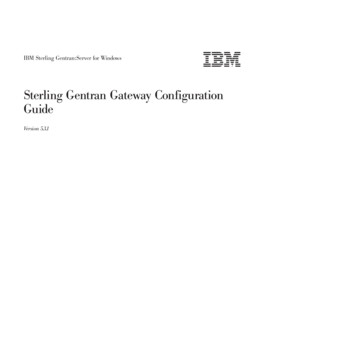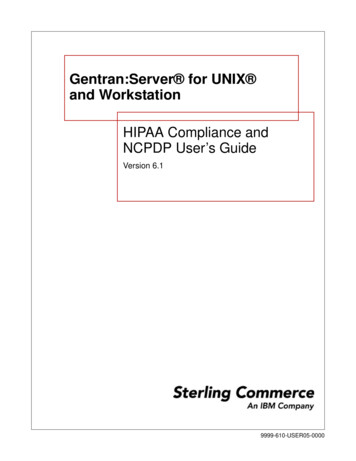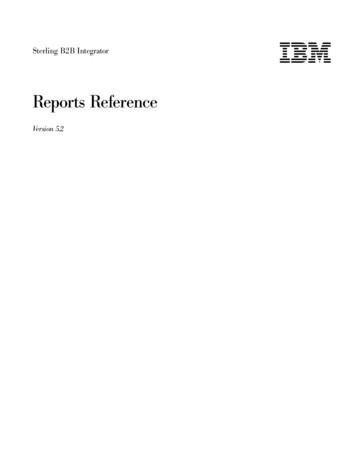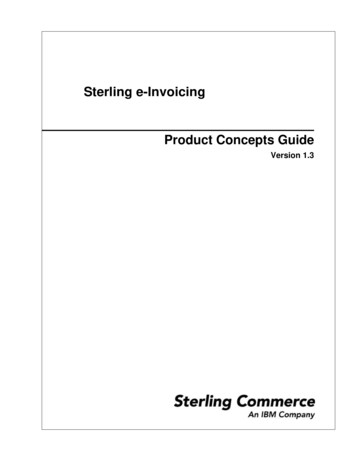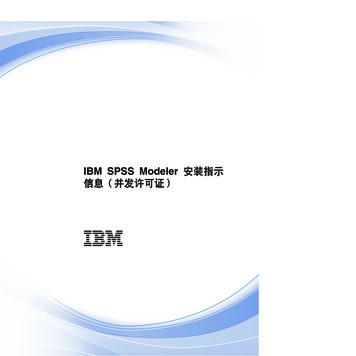
Transcription
IBM Sterling Gentran:Server for iSeriesCommunications GuideRelease 3.60241-350-COMM01-0001
This edition applies to the 3.6 Version of IBM Sterling Gentran:Server for iSeries and to allsubsequent releases and modifications until otherwise indicated in new editions.Before using this information and the product it supports, read the information in Notices on pageN-1.Licensed Materials - Property of IBMIBM Sterling Gentran:Server for iSeries Copyright IBM Corp. 1990, 2011. All Rights Reserved.US Government Users Restricted Rights - Use, duplication or disclosure restricted by GSA ADPSchedule Contract with IBM Corp.
Table of ContentsPrefaceBefore You BeginHow is the Documentation Organized? . P-1In this Book . P-1What is in Each Chapter? . P-2Other Sterling Gentran:Server for iSeries Manuals . P-4Chapter 1Using CommunicationsIn this Chapter . 1-1What Is Communications? . 1-2What Does the Communications Subsystem Do? . 1-2Take a Closer Look at Communications . 1-4Panel Quick Reference . 1-6Access the Communications Subsystem . 1-15Communications Setup . 1-19Copy Profiles and Scripts . 1-65Process Inbound Files . 1-71Operations and Management of Communications . 1-73Use the ezCOMM Command . 1-137Reports . 1-140Common Questions . 1-152Chapter 2Using ScriptsWork with Session Control Scripts . 2-1Script Decision Tables . 2-9Extended Script Logic . 2-22Remote Command Support . 2-27What is Dynamic Scripting? . 2-33Sync Extended Script Logic . 2-37Chapter 3Bisync Communications SupportIntroduction . 3-1Bisync Configuration . 3-2BSC Tables . 3-13BSC Print Carriage Control Conversion . 3-16Communications Guidei
Table of ContentsRequirements Checklist . 3-17Chapter 4SNA Communications SupportIntroduction . 4-1SNA/LU0 Configuration . 4-2SNA/LU0 Tables . 4-11Remote Program Start Request . 4-14Connect:Mailbox/Supertracs . 4-21Communicate with JES2 SNA . 4-29Chapter 5SNA LU6.2 Communications SupportIntroduction . 5-1LU6.2 Configuration . 5-2X62/L62 Tables . 5-10LU6.2 via SDLC Examples . 5-13LU6.2 via X.25 Examples . 5-33Chapter 6Asynchronous Communication SupportOverview of Asynchronous Data Transmission . 6-1Asynchronous Protocols . 6-1Modem Considerations . 6-2Error Detection and Correction . 6-4Clear To Send . 6-4AT or V.25bis Command Set . 6-5Default Modem Strings in the Profile . 6-6Modem Initialization Commands . 6-7Modem Dialing Commands . 6-8Receive Calls . 6-9Flow Control . 6-10Translation . 6-11Translation Examples . 6-13Scripting Considerations . 6-14Basic Scripting Concepts . 6-14Supported Script Transaction Types and Actions . 6-16Use of ETX, EOT, and End-of-Cmd Characters . 6-19Use of the Command Field . 6-20Explanation of Script Indicators . 6-21Asynchronous Extended Script Logic . 6-23“Create Your Own” Protocol . 6-31Print Control . 6-33iiCommunications Guide
Table of ContentsDynamic Scripting . 6-34Evoke Considerations . 6-35Asynchronous (ASC) Communication Examples . 6-37Asynchronous (XAS) via X.25 Examples . 6-49Chapter 7XMODEM File Transfer SupportIntroduction . 7-1Considerations . 7-2Configuration . 7-4Chapter 8OFTP Communication SupportOverview . 8-1Create an OFTP Profile . 8-5Create an OFTP Script . 8-15Chapter 9FTP Communication SupportIntroduction . 9-1Considerations . 9-2Sterling Gentran:Server FTP Configuration . 9-7FTP Communication Session Control Scripts . 9-12Using the FTP Server Interface . 9-36Chapter 10 MQSeries InterfaceIn this Chapter . 10-1Overview of MQSeries Interface . 10-1Using the MQ Link Panels . 10-3Sterling Gentran:Server MQSeries Configuration . 10-11Send Files to MQSeries . 10-13Receive Files from MQSeries . 10-15Report . 10-17Chapter 11 Using Line PoolsIn this Chapter . 11-1Introduction . 11-1How Line Pools Work with Sterling Gentran:Server Communications . 11-1Chapter 12 IFS GatewayIn this Chapter . 12-1What is GIFSGATE? . 12-2Communications Guideiii
Table of ContentsHow to Use the GIFSGATE Command . 12-4How to Use the GENIBQIFS Command . 12-13Stopping the IFS Gateway . 12-17Appendix 1Modems: Configuration and TroubleshootingOverview . A-1Configuration Requirements . A-4Troubleshooting Problems . A-4Additional Support . A-5Appendix 1Translating between ASCII and EBCDICOutbound Translation Table (EBCDIC-to-ASCII) .B-2Inbound Translation Table (ASCII-to-EBCDIC) .B-3NoticesGlossaryIntroduction . G-1Definition of Terms . G-1IndexivCommunications Guide
PrefaceBefore You BeginHow is the Documentation Organized?Information about IBM Sterling Gentran:Server is available through both online help and userdocumentation (provided on CD-ROM). Online help contains reference material (paneldefinitions, field definitions, etc.). It gives you quick access to relevant information as you areusing the IBM Sterling Gentran:Server for iSeries system. The user documentation, on theother hand, describes procedures (“how to. . .”) and is intended to complement and enhance theonline help.In this BookThe IBM Sterling Gentran:Server for iSeries Communications Guide is comprised of elevenchapters, two appendices, a glossary of communication terms, and an index. The first chapter,Using Communications, is presented in a tutorial format and is intended as an instructionalprocedural reference. The other chapters cover specific communications topics, such as one of thesupported protocols or line pools, in greater detail. To get the most out of these chapters, werecommend that you start by reading the first chapter thoroughly to familiarize yourself with thebasics of Sterling Gentran:Server communications. The other chapters are intended for morereferential use, and they will be more easily understood if you are familiar with the basicinformation presented in the Using Communications chapter.# NOTEDue to the uniqueness of each implementation, the predefined Communication scripts areprovided as examples only and are intended to assist you in getting started. Please read theIBM Sterling Gentran:Server for iSeries User Guide provided by your value-addednetwork or communication partner to ensure that the setup correctly reflects their specificrequirements.Communications GuideP-1
What is in Each Chapter?PrefaceWhat is in Each Chapter?Chapter 1Using CommunicationsThis chapter illustrates the use of the communications subsystem within SterlingGentran:Server for iSeries. General information sections explain the capabilities of thesoftware and the concepts upon which the subsystem is based. The general information issupplemented by step-by-step examples, presented in a tutorial format, that detail how thecommunications subsystem is used. Information in this section is intended for all users ofthe communications subsystem.Chapter 2Using ScriptsThis chapter contains detailed information about creating and using communicationsscripts, including extended script logic, remote command support, and dynamic scripting.Chapter 3Bisync Communications SupportThis chapter covers specific information about using bisynchronous communications withthe Sterling Gentran:Server communications subsystem.Chapter 4SNA Communications SupportThis chapter covers specific information about using SNA/LU0 communications with theSterling Gentran:Server communications subsystem.Chapter 5SNA LU6.2 Communications SupportThis chapter covers specific information about using the optional add-on SNA LU6.2module (purchased separately) with the Sterling Gentran:Server communicationssubsystem.Chapter 6Asynchronous Communications SupportThis chapter covers specific information about using the optional add-on asynchronousmodule (purchased separately) with the Sterling Gentran:Server communicationssubsystem.Chapter 7XMODEM File Transfer SupportThis chapter contains information about using XMODEM. You must also have theasynchronous add-on module to use XMODEM.Chapter 8OFTP Communications SupportThis chapter contains information about using the Odette File Transfer Protocol (OFTP).You must also have the asynchronous add-on module to use OFTP.Chapter 9P-2FTP Communications SupportCommunications Guide
PrefaceWhat is in Each Chapter?This chapter covers specific information about using the optional add-on File TransferProtocol (FTP) module (purchased separately) with the Sterling Gentran:Servercommunications subsystem.Chapter 10MQSeries InterfaceThis chapter covers information about the Sterling Gentran:Server interface withMQSeries.Chapter 11Using Line PoolsThis chapter covers specific information about using line pools with SterlingGentran:Server communications. Line pools enable you to have a number ofcommunications jobs active at one time, all sharing the same “pool” of up to five iSeriesline resources.Chapter 12IFS GatewayThis chapter covers GIFSGATE, an interface between Sterling Gentran:Server for iSeriesand the Integrated File System (IFS). The IFS gateway is installed as a standard part ofSterling Gentran:Server for iSeries and no additional installation procedures are required.Appendix A.Modems: Configuration and TroubleshootingThis appendix contains a list of recommended modems for use with SterlingGentran:Server, and troubleshooting tips.Appendix B.Translating between ASCII and EBCDICThis appendix contains a translation table for EBCDIC to ASCII, and one for ASCII toEBCDIC translations.Communications GuideP-3
Other Sterling Gentran:Server for iSeries ManualsPrefaceOther Sterling Gentran:Server for iSeriesManualsThe Sterling Gentran:Server for iSeries documentation set includes several other manuals andinstructional materials. The following publications are available as part of the licensed system: IBM Sterling Gentran:Server for iSeries Manager’s Implementation PlannerThe Manager’s Implementation Planner is designed to assist you with the process ofcollecting, organizing and prioritizing the information required to successfully implementEDI. The Planner includes EDI tutorial materials and other planning and implementationmaterials. IBM Sterling Gentran:Server for iSeries User GuideThe User Guide is task oriented. Use the Table of Contents to locate information about specifictasks and procedures. Use the index to locate information regarding individual panels or fielddefinitions. For more detailed descriptions of individual panels and field definition, please usethe online help. Apart from the opening chapter, “System Essentials”, which everyone shouldread, most Sterling Gentran:Server users will not need to read every chapter in this manual. IBM Sterling Gentran:Server for iSeries Technical Reference GuideThe Technical Reference Guide is now a fully searchable online manual. The TechnicalReference Guide includes information on advanced topics, program and command names, andsystem messages. IBM Sterling Gentran:Server for iSeries Release 3.6 Installation GuideThe Installation Guide provides step-by-step installation and conversion instructions. Pleaseread all the instructions before beginning the installation.P-4Communications Guide
Chapter1Using CommunicationsIn this ChapterSterling Gentran:Server for iSeries Communications software allows you to configure, operate,and manage communications between your system and third-party networks or directcommunication partners. This chapter includes specific information and exercises to help you setup and manage your communications. This chapter covers the following topics:¾ What Is Communications? . . . . . . . . . . . . . . . . . . . . . . . . . . . . . . . . . . . . . . . . . . . . . . . 1-2¾ What Does the Communications Subsystem Do?. . . . . . . . . . . . . . . . . . . . . . . . . . . . . . 1-4¾ Take a Closer Look at Communications . . . . . . . . . . . . . . . . . . . . . . . . . . . . . . . . . . . . 1-4 Communications Setup . . . . . . . . . . . . . . . . . . . . . . . . . . . . . . . . . . . . . . . . . . . . . . 1-4 Operations and Management of Communications . . . . . . . . . . . . . . . . . . . . . . . . . 1-4¾ Panel Quick Reference . . . . . . . . . . . . . . . . . . . . . . . . . . . . . . . . . . . . . . . . . . . . . . . . . . 1-6¾ Access the Communications Subsystem . . . . . . . . . . . . . . . . . . . . . . . . . . . . . . . . . . . 1-15¾ Communications Setup . . . . . . . . . . . . . . . . . . . . . . . . . . . . . . . . . . . . . . . . . . . . . . . . 1-19 Communication Profiles . . . . . . . . . . . . . . . . . . . . . . . . . . . . . . . . . . . . . . . . . . . . 1-20 Communications Session Control Scripts . . . . . . . . . . . . . . . . . . . . . . . . . . . . . . . 1-32 Network Scripts . . . . . . . . . . . . . . . . . . . . . . . . . . . . . . . . . . . . . . . . . . . . . . . . . . . 1-42¾ Copy Profiles and Scripts . . . . . . . . . . . . . . . . . . . . . . . . . . . . . . . . . . . . . . . . . . . . . . . 1-65 Copy Communication Profiles . . . . . . . . . . . . . . . . . . . . . . . . . . . . . . . . . . . . . . . 1-65 Copy Communication Scripts . . . . . . . . . . . . . . . . . . . . . . . . . . . . . . . . . . . . . . . . 1-68 Copy Communication Script Records . . . . . . . . . . . . . . . . . . . . . . . . . . . . . . . . . . 1-70¾ Process Inbound Files . . . . . . . . . . . . . . . . . . . . . . . . . . . . . . . . . . . . . . . . . . . . . . . . 1-71¾ Operations and Management of Communications . . . . . . . . . . . . . . . . . . . . . . . . . . . . 1-73 Operations . . . . . . . . . . . . . . . . . . . . . . . . . . . . . . . . . . . . . . . . . . . . . . . . . . . . . . . 1-73 Management . . . . . . . . . . . . . . . . . . . . . . . . . . . . . . . . . . . . . . . . . . . . . . . . . . . . . 1-73 Initiate Communication Sessions . . . . . . . . . . . . . . . . . . . . . . . . . . . . . . . . . . . . . 1-74 Monitor Active Communication Sessions . . . . . . . . . . . . . . . . . . . . . . . . . . . . . . . 1-81 View the Communications History Log . . . . . . . . . . . . . . . . . . . . . . . . . . . . . . . . 1-83 Manage the Outbound Queue . . . . . . . . . . . . . . . . . . . . . . . . . . . . . . . . . . . . . . . . 1-92 Find a String of Data in the Comm Queues . . . . . . . . . . . . . . . . . . . . . . . . . . . . 1-103Communications Guide1-1
What Is Communications?Using Communications IFS Gateway . . . . . . . . . . . . . . . . . . . . . . . . . . . . . . . . . . . . . . . . . . . . . . . . . . . . 1-105 Manage the Inbound Queue . . . . . . . . . . . . . . . . . . . . . . . . . . . . . . . . . . . . . . . . . 1-107 Gentran IBQ to IFS Gateway . . . . . . . . . . . . . . . . . . . . . . . . . . . . . . . . . . . . . . . 1-118 Add Data to Queues . . . . . . . . . . . . . . . . . . . . . . . . . . . . . . . . . . . . . . . . . . . . . . . 1-119 Extract Data from Queues . . . . . . . . . . . . . . . . . . . . . . . . . . . . . . . . . . . . . . . . . . 1-123 Purge the Communications Files . . . . . . . . . . . . . . . . . . . . . . . . . . . . . . . . . . . . . 1-127¾ Use the ezCOMM Command . . . . . . . . . . . . . . . . . . . . . . . . . . . . . . . . . . . . . . . . . . . 1-137¾ Reports . . . . . . . . . . . . . . . . . . . . . . . . . . . . . . . . . . . . . . . . . . . . . . . . . . . . . . . . . . . . 1-140 EBDI078 — Sterling Gentran:Server EDI Data Print Report . . . . . . . . . . . . . . . 1-140 EBDI074 — Sterling Gentran:Server Comm Queue Search Report . . . . . . . . . . 1-143 EBDI081 — Print Communications History Report (PRTCOMHST) . . . . . . . . 1-145¾ Common Questions . . . . . . . . . . . . . . . . . . . . . . . . . . . . . . . . . . . . . . . . . . . . . . . . . . 1-152What Is Communications?Communications is the process by which you send/receive data to/from Value-Added Networks(VANs) or direct communication partners. In order to do this, you must define communicationprofiles, write and/or copy scripts, and initiate communication sessions. Successfulcommunications requires hardware information related to modems, dialers, and lines, as well assoftware related information such as options regarding record separators and blank suppression.What Does the CommunicationsSubsystem Do?The Communications subsystem provides the following capabilities:1-2 Create, copy, and maintain Communication Profiles and scripts (predefined profiles andscripts are provided for major EDI networks) Initiate and terminate communication sessions Monitor active communication sessions Manage the data in the Inbound and Outbound Queues (repositories for the EDI data thatis sent and received) View the Communication History log to see the results of communication sessions Purge and retrieve the History log and the Inbound and Outbound Queues Perform Dynamic Scripting and Remote Command SupportCommunications Guide
Using CommunicationsWhat Does the Communications Subsystem Do? Continuously process communication sessions Perform a Communications Trace for troubleshootingCommunications Guide1-3
Take a Closer Look at CommunicationsUsing CommunicationsTake a Closer Look at CommunicationsThe Communications feature can be divided into two major components: the communicationssetup (profiles and scripts) and the operations and management of communications.Communications SetupSterling Gentran:Server provides predefined communication profiles (comm profiles) and scriptsfor the major EDI networks. When setting up for your communication sessions, you can modifyone of these predefined profiles or create a new profile with the information about yourconfiguration.The profile contains information (that is, protocol, manual or auto dial, the number to dial)necessary to establish and use the link to the remote system. The script defines the “conversation”that the two systems conduct over the communications line.Sterling Gentran:Server provides a utility, the Network Profile feature, that can be used with mostof the predefined profiles and scripts for quick “customizing.” It recognizes the network valuesand replaces them with your identifiers supplied by the VAN, such as the Mailbox ID and thepassword. This utility can be used with any profile classified as a “network profile.”# NOTEDue to the uniqueness of each implementation, the predefined Communication scripts areprovided as examples only and are intended to assist in getting you started. Please read theIBM Sterling Gentran:Server for iSeries User Guide provided by your value-addednetwork or communication partner to ensure that the setup correctly reflects their specificrequirements.Operations and Management of CommunicationsOperations refers to the initiation and monitoring of communication sessions. A “session” is whenthe actual transfer of data occurs. Each session is a planned connection between your system and aspecific network or a particular direct communication partner. As with all Sterling Gentran:Servercommands, the Start Communications Session (STRCOMSSN) command can be run one of threeways: Scheduled to run in batch at a later time Submitted to run in batch immediately Executed interactively (immediately)# NOTESEE the “Job Scheduler” chapter in the IBM Sterling Gentran:Server for iSeries Technical Reference Guide for more information on scheduling communication sessions.1-4Communications Guide
Using CommunicationsTake a Closer Look at CommunicationsActive sessions can be monitored from within Sterling Gentran:Server allowing the user toperform all operational tasks on the session from a central location. Effective management of thecommunications data is an essential process in the day-to-day operation of your EDI system. Thisincludes managing and controlling the actual EDI data to retransmit, reprocess, view, purge, andretrieve. Details of all comm sessions can be viewed in the History log and later purged. Periodicpurges help to maintain efficient throughput.Figure 1.1 depicts the Communications subsystem.Sterling Gentran:Server for fileInvoiceScriptSPOOLOutboundUser FileiSeries(Leased Line)Modem(Switched Line)WAN/InternetVANTrading PartnerFigure 1.1 Communications Subsystem DiagramCommunications Guide1-5
Panel Quick ReferenceUsing CommunicationsPanel Quick ReferenceThe following table gives the purpose and access method for all of the Work with Communicationpanels in this chapter.Panel NameGENCOMCommunications MenuEDIX400-FMT01Work withCommunicationsEDIX401-FMT01Communication Profile— Part 1EDIX401-FMTnnCommunication Profile— Part 2 (where ‘nn’ is02-09)EDIX401-FMT20Communication Profile— Part urposeAccess all communicationsfunctions from a menu.Access Methods Select option ‘4’ on the GENMAINmenu Type ‘GO GENCOM’ on thecommand line Type ‘J COM’ on the command lineAccess all Communications Select option ‘1’ on the GENCOMmenufunctions Type ‘EXCPGM EDIX400’ on thecommand line Type ‘J CM’ on the command line Select an option (1-5) on panelEDIX400-FMT01 Type ‘EXCPGM EDIX401’ on thecommand lineDefine the configurationinformation for the profile.Formats vary depending onthe protocol Press Enter or F8 (Next) on panelEDIX401-FMT01 Press F10 (Update) in add mode onpanel EDIX401Define the line, controller,and device description Press Enter or F8 (Next) onCommunications Profile Part 2(EDIX401-FMT02 thruEDIX401-FMT09)View or revise the line,control, and devicedescription names Select option ‘11’ on panelEDIX400-FMT01 Type ‘EXCPGM EDIX819’ on thecommand lineDefine the Protocol andFIFO/LIFO methodCommunications Guide
Using CommunicationsPanel NameEDIX402-FMT01Work nSession ControlEDIX43B-FMT01CommunicationSession ControlExtended ParmsEDIX43C-FMT01Communication EvokeEDIX817-FMT01Work withCo
IBM Sterling Gentran:Server for iSeries Manager's Implementation Planner The Manager's Implementation Planner is d esigned to assist you with the process of collecting, organizing and prioritizing the information required to successfully implement EDI. The Planner includes EDI tutorial materials and other planning and implementation
